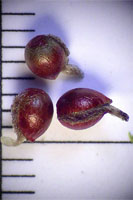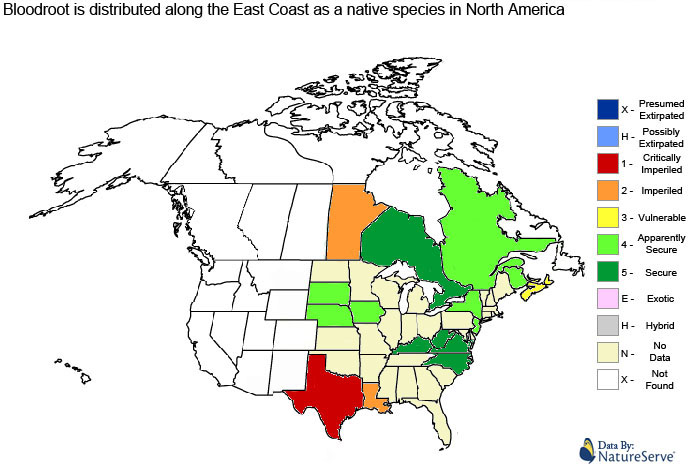

| Plant Name | Bloodroot | |
| Scientific Name | Sanguinaria Canadensis | |
| Family | Poppy | |
| Plant Type | Perennial | |
| Start of Blooming Season | March | |
| End of Blooming Season | May |

| Soil Conditions | |
| Soil Moisture | |
| Sunlight | |
| Notes: |

Bloodroot grows from 5cm to 15cm tall with one large basal palmately scalloped leaf up to 12cm across, with five to nine lobes. The leaves and flowers sprout from a reddish rhizome with bright orange sap that grows at or slightly below the soil surface. The rhizomes grow longer each year, and branch to form colonies. Plants start to bloom before the foliage unfolds in early spring. After blooming the leaves expand to their full size and go summer dormant in mid to late summer. The flowers bloom from March to May depending on the region and weather. They have 8 to 12 delicate white petals and yellow stamens, and two sepals below the petals, which fall off after the flowers open. The flower stems are clasped by the leaves. The flowers are pollinated by small bees and flies. Seeds develop in green pods which are 40mm to 60mm long, and ripen before the foliage goes dormant. The seeds are round and black to orange-red when ripe, and have white elaiosomes, which are eaten by ants.
Other than in the basic natural form, bloodroot can be found in one distinct variety:

| Plant Height | 5cm to 15cm |
| Habitat | Rich woodlands and close to streams |
| Leaves | Palmately scalloped into five to nine lobes |
| Leaf Margin | Lobate |
| Leaf Venation | Reticulate |
| Stems | Smooth Stems |
| Flowering Season | March to May |
| Flower Type | Radially Symmetrical |
| Flower Colour | White |
| Pollination | Bees, Insects |
| Flower Gender | Flowers are hermaphrodite and the plants are self-fertile |
| Fruit | Hard oval seeds |
| USDA Zone | 4B (-28°C to -31°C) cold weather limit |

The following health hazards should be noted when handling or choosing a location to plant bloodroot:
 |
TOXIC Bloodroot contains many alkaloids and is poisonous in large doses. Bloodroot should not be used by women when they are pregnant or lactating. The sap, fresh or dried, can cause intense irritation to the mucous membranes. |

 |
-Click here- or on the thumbnail image to see an artist rendering, from The United States Department of Agriculture, of bloodroot. (This image will open in a new browser tab) |

 |
-Click here- or on the thumbnail image to see a magnified view, from Minnesota Wildflowers, of the seeds created by bloodroot for propagation. (This image will open in a new browser tab) |

Bloodroot can be referenced in certain current and historical texts under the following five names: Bloodroot can be translated into the following select languages: |
|||||||||||||
| Arabic | Bulgarian | Chinese (Sim) | |||||||||||
| Croatian | Czech | Danish | |||||||||||
| Dutch | Esperanto | Estonian | kevadmagun | ||||||||||
| Finnish | French | German | Blutwurz | ||||||||||
| Greek | Hebrew | Hungarian | |||||||||||
| Italian | Sanguinaria | Japanese | 赤根草 | Korean | |||||||||
| Punjabi | Lithuanian | Norwegian | |||||||||||
| Persian | Polish | Portuguese | |||||||||||
| Romanian | Russian | лапчатка | Slovak | ||||||||||
| Spanish | sanguinaria | Swedish | blodrot | Tagalog | |||||||||
| Turkish | bahar güzelliği | Ukrainian | перстач | Vietnamese | |||||||||

| The information provided in this conservation assessment has been provided by the Natureserve Database in conjunction with various federal, provincial, state, county, district, regional, and municipal governments as well as public and private conservation authorities. Information in this section is accurate from the last time this article was updated. |
|
 |
Bloodroot is considered to be a secure native species in North America. |

 |

 |
The MIROFOSS database offers free printable garden tags for personal and non-profit use. These tags can be used to properly identify plant samples in a garden. Click on the tags shown on the the screen or -click here- to download a full size jpeg image for a bloodroot identification tag; which can be printed on paper or used with a plastic laser printer. |
 |
What's this? What can I do with it? |

| Description | Brumback, W.E., and L. J. Mehrhoff. 1996. Flora Conservanda: New England. The New England Plant Conservation Program list of plants in need of conservation. Rhodora 98 (895): 235-361. |
| Description | Kartesz, J.T. 1994. A synonymized checklist of the vascular flora of the United States, Canada, and Greenland. 2nd edition. 2 vols. Timber Press, Portland, OR. |
| Commerical Uses | Bouquot, Brad W. Neville , Douglas D. Damm, Carl M. Allen, Jerry E. (2002). Oral & maxillofacial pathology (2. ed.). Philadelphia: W.B. Saunders. p. 338. ISBN 0721690033. |
| Folklore | MacKinnon, Kershaw, Arnason, Owen, Karst, Hamersley, Chambers. 2009. Edible & Medicinal Plants Of Canada ISBN 978-1-55105-572-5 |
| Image Rendering | USDA-NRCS PLANTS Database / USDA NRCS. Wetland flora: Field office illustrated guide to plant species. USDA Natural Resources Conservation Service. |
| Environment | National Audubon Society. Field Guide To Wildflowers (Eastern Region): Alfred A. Knopf. ISBN 0-375-40232-2 |
| Physical Identification | National Audubon Society. Field Guide To Wildflowers (Eastern Region): Alfred A. Knopf. ISBN 0-375-40232-2 |
| October 01, 2015 | The last time this page was updated |
| ©2021 MIROFOSS™ Foundation | |
 |




